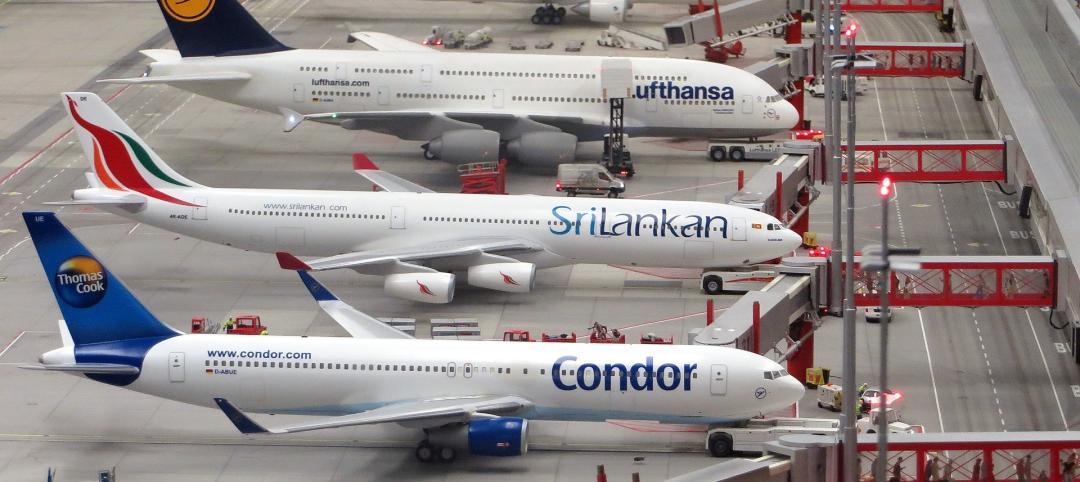In June, the Dwight D. Eisenhower National Airport in Wichita, Kan., opened a new 275,000-sf, 12-gate terminal. According to an airport press release, the new facility “expresses …Wichita’s globally prominent position in Aviation as the Air Capital of the World.” The $200 million-plus terminal (which includes a new consolidated rental car facility) can handle two million passengers annually. It was designed (by HTNB) to support future growth up to 2.4 million.
Passenger traffic at the airport (formerly known as Wichita Mid-Continent Airport) was about 1.5 million in 2014, up 6% from the previous year. As of mid-2015, it is running about even with last year, says Victor White, Wichita Airport Authority’s Director of Airports.
Regional airports like Eisenhower National—which offers flights to and from Atlanta, Chicago, Dallas, Denver, Houston, Las Vegas, Los Angeles, Minneapolis-St. Paul, and Phoenix—are doing everything they can to hold onto business. But small-to-midsize airports are still battling for their lives, as big carriers are cut or eliminate service to non-hub cities.
A 2013 report from Massachusetts Institute of Technology’s International Center for Air Transportation found that small- and medium-sized airports ”have been disproportionally affected by reductions in service,” with medium-sized airports having felt “the biggest brunt” of airline network strategies.
This report predicts that smaller airports close to major hubs could be at risk of losing all of their carrier service by 2018. That’s bad news for local municipalities that see their airports as economic engines.
San Luis Obispo County (Calif.) Regional Airport is a case in point. In 2008 Delta ceased service to Salt Lake City, U.S. Air discontinued flights to Las Vegas, and American Airlines pulled out of the airport altogether. About 60% of travelers in this region now fly out of Los Angeles or the San Francisco Bay Area, according to The Tribune, a newspaper that covers this market.
County officials believe San Luis Obispo’s prosperity hinges on its airport’s growth. Despite ongoing discussions with several carriers, the airport has had trouble finding airlines willing to provide service to Dallas, Salt Lake, or Denver.
White says that over the past decade, Wichita’s airport has managed to grow through aggressive marketing and airline recruitment. Four of the nation’s largest carriers—American, Delta, United, and Southwest—all fly out of Eisenhower, as does Allegiant Air, which caters to leisure travelers.
Wichita’s airport was also one of the first to offer incentives to carriers in the form of guaranteeing revenue and other subsidies, a practice that is now common among small and medium size airports. “Southwest Airlines wouldn’t have come here if we hadn’t provided guarantees and subsidies,” White says.
Rent income from airlines is one of the revenue streams that Wichita tapped to pay for its new terminal, along with user fees, commissions on retail sales, and a $4.50 per passenger facility fee. It also received a $60 million FAA grant, and another $7 million from TSA, says White.
The MIT report noted that while airlines have been grounding their older, smaller turbo planes and moving to larger jets with more seats, they still aren’t offering small and midsize airports enough flights to match demand.
At Eisenhower, White says that carriers are mostly flying Airbus or Boeing jets. But, he’s quick to add, demand continues to outpace availability. “The biggest complaint that passengers have is that flights are too full and it is hard to find a seat at the time and price they want to fly.”
Related Stories
Urban Planning | Feb 5, 2024
Lessons learned from 70 years of building cities
As Sasaki looks back on 70 years of practice, we’re also looking to the future of cities. While we can’t predict what will be, we do know the needs of cities are as diverse as their scale, climate, economy, governance, and culture.
Products and Materials | Jan 31, 2024
Top building products for January 2024
BD+C Editors break down January's top 15 building products, from SloanStone Quartz Molded Sinks to InvisiWrap SA housewrap.
Airports | Jan 30, 2024
Rafael Viñoly Architects’ design for the new Florence, Italy, airport terminal will feature a rooftop vineyard
At Florence, Italy’s Aeroporto Amerigo Vespucci, the new international airport terminal will feature a fully operating vineyard on the facility’s rooftop. Designed by Rafael Viñoly Architects, the terminal is expected to see over 5.9 million passengers annually. Renderings for the project have recently been released.
Airports | Jan 15, 2024
How to keep airports functional during construction
Gensler's aviation experts share new ideas about how to make the airport construction process better moving forward.
Airports | Dec 4, 2023
4 key innovations and construction trends across airport design
Here are some of the key trends Skanska is seeing in the aviation sector, from congestion solutions to sustainability.
Giants 400 | Nov 13, 2023
Top 60 Airport Facility Construction Firms for 2023
Hensel Phelps, Turner Construction, AECOM, and Walsh Group top BD+C's ranking of the nation's largest airport terminal and airport facilities general contractors and construction management (CM) firms for 2023, as reported in the 2023 Giants 400 Report.
Giants 400 | Nov 13, 2023
Top 65 Airport Facility Engineering Firms for 2023
AECOM, Jacobs, Arup, Burns & McDonnell, and WSP head BD+C's ranking of the nation's largest airport terminal and airport facilities engineering and engineering architecture (EA) firms for 2023, as reported in the 2023 Giants 400 Report.
Giants 400 | Nov 13, 2023
Top 65 Airport Facility Architecture Firms for 2023
Gensler, Corgan, PGAL, and HOK top BD+C's ranking of the nation's largest airport terminal and airport facilities architecture and architecture engineering (AE) firms for 2023, as reported in the 2023 Giants 400 Report.
Building Materials | Oct 2, 2023
Purdue engineers develop intelligent architected materials
Purdue University civil engineers have developed innovative materials that can dissipate energy caused by various physical stresses without sustaining permanent damage.
Products and Materials | Sep 29, 2023
Top building products for September 2023
BD+C Editors break down 15 of the top building products this month, from smart light switches to glass wall systems.

















